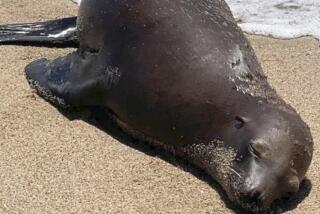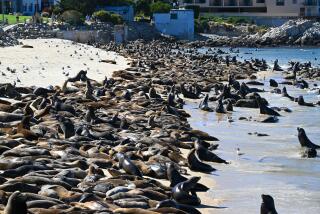Scientists Investigate Declining Numbers of Stellar Sea Lions
KODIAK, Alaska â Kate Wynne peers through an illuminated magnifying glass at the bits of digested salmon bones, gills, teeth and shrimp shells extracted from a pile of Steller sea lion dung.
The sample provides a snapshot of what one sea lion chose to eat on one particular winter day from what was available in the waters around Kodiak.
âThereâs a pretty big difference, both regionally and seasonally, in what theyâre eating,â said Wynne, a marine mammal biologist with the University of Alaska Fairbanks.
In the lab at the Kodiak Fisheries Research Center, Wynne is studying the diet of the endangered animals in hopes of finding clues to their dwindling numbers.
One day each month, armed with a trowel and plastic bags, she visits rocky sea lion haul-outs around Kodiak Island, carefully collecting the dung after shooing the big animals into the water.
âItâs better than trying to collect stomach samples from dead animals. Itâs a renewable resource, easily accessible and fairly cheap. It disturbs them very little,â she said.
By collecting and carefully analyzing hundreds of samples, Wynne hopes to develop a better understanding of the sea lionâs relationship to other species in the ecosystem.
Wynneâs dietary study is one of dozens of projects probing the mystery of the sea lionâs decline. Over the last three decades, the Steller sea lion population in the Bering Sea and the western Gulf of Alaska has declined by about 80%. The animals now number about 33,600.
Steller sea lion studies, including Wynneâs, are getting a huge boost with $43 million in federal research funds contained in the fiscal 2001 budget, formulated by former President Clinton. Thatâs 10 times the amount allocated a year before.
âWeâve never had resources on this scale to work on this stuff before,â said Jim Coe, acting science director for the National Oceanic and Atmospheric Administrationâs Alaska Fisheries Science Center in Seattle. âI wish I had it 10 years ago.â
With the windfall comes pressure to come up with an answer-- soon--to the mystery of sea lion dynamics.
Environmental groups say the answer is clear. They blame the pollock fishery. The pollock harvest is the nationâs largest fishery. The white fish is turned into fish fillets for fast food restaurants, imitation crab and fish sticks.
Greenpeace and other environmental groups sued the National Marine Fisheries Service seeking limits on fishing to protect the sea lions. Under orders from a federal judge to provide a biological explanation for the sea lionsâ decline, the fisheries service concluded that many factors, including environmental changes, contribute to the problem. But the agency said commercial fishing was a significant factor.
Sen. Ted Stevens (R-Alaska) hotly disputed that finding. In a late-session budget battle, Stevens won the research money and a delay in tough new restrictions on where and when the commercial fleet can catch fish.
If that research brings new information, the fisheries service may retool its biological opinion, Coe said.
So in the coming months, all eyes will be on the sea lion. Scientists will be looking at the effects of swings in ocean temperatures and resulting changes in fish populations; the role of predators such as killer whales and sharks; disease, contaminants and the role humans play in the sea lion story.
Scientist met in Seattle in late January to coordinate the research. Agencies involved besides the fisheries service include the National Ocean Service, the Alaska Department of Fish and Game, the Alaska SeaLife Center, University of Alaska and the North Pacific Universities Marine Mammal Research Consortium.
Wynneâs painstaking work will seek to solve just one small piece of the mystery. Itâs both frustrating and rewarding.
âPeople want immediate answers. Itâs frustrating to give them just a little piece of the answer,â Wynne said. âI feel really fortunate to be able to watch this. It raises every biological question youâve ever come across.â
More to Read
Sign up for Essential California
The most important California stories and recommendations in your inbox every morning.
You may occasionally receive promotional content from the Los Angeles Times.










